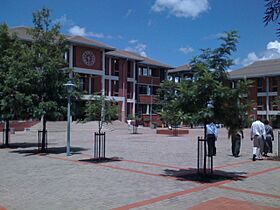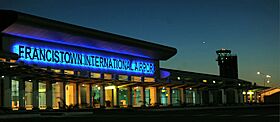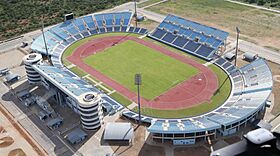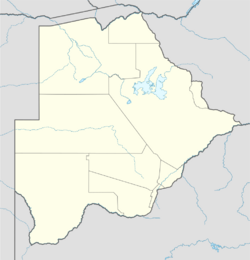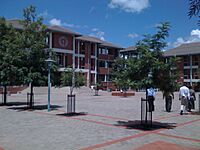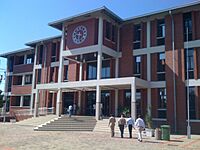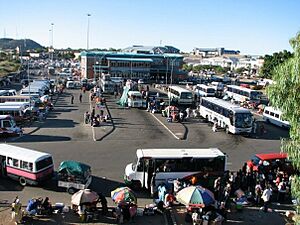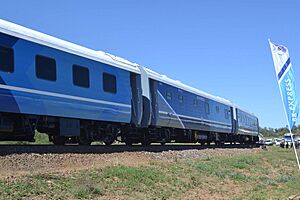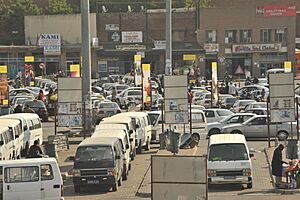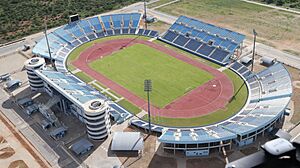Francistown facts for kids
Quick facts for kids
Francistown
|
||
|---|---|---|
|
Top to bottom: Institute of Health Sciences in Francistown CBD, Phillip Gaonwe Matante International Airport, Obed Itani Chilume Stadium
|
||
|
||
| Country | ||
| District | North-East District | |
| Founded | 1897 | |
| Incorporated as a city | 1997 | |
| Named for | Daniel Francis | |
| Government | ||
| • Type | City commission government | |
| • Body | City of Francistown Council | |
| Area | ||
| • City | 79 km2 (31 sq mi) | |
| Elevation | 1,001 m (3,284 ft) | |
| Population
(2022 census)
|
||
| • City | 103,417 | |
| • Density | 1,309/km2 (3,390/sq mi) | |
| • Metro | 147,122 | |
| Time zone | UTC+2 (Central Africa Time) | |
| • Summer (DST) | UTC+2 (not observed) | |
| Geographical area code | 2XX | |
| ISO 3166 code | BW-FR | |
| Climate | BSh | |
Francistown is the second-largest city in Botswana, a country in Southern Africa. About 103,417 people live in the city itself. If you include the surrounding areas, the population is around 147,122, based on the 2022 census.
The city is located in eastern Botswana. It is about 400 kilometers (250 miles) north-northeast of Gaborone, the capital city. Francistown sits where the Tati and Ntshe rivers meet. It is also close to the Shashe River and about 90 kilometers (56 miles) from the border with Zimbabwe.
Francistown was once the center of Southern Africa's first gold rush. Even today, you can find old, abandoned mines around the city. Francistown is its own administrative area, separate from the North-East District. The city is managed by the Francistown City Council. The main language spoken here is Kalanga. Other languages like isiNdebele, ChiShona, and SeTswana are also used. Francistown is special because it is the only city in Botswana with an English name.
Contents
History of Francistown
People have lived in the Francistown area for about 10,000 years. However, written records are much more recent. History shows that Francistown began as a village of the BaKalanga people. The nearby village of Nyangabgwe was the first place in the area visited by Europeans. The missionary Robert Moffat visited it first.
In 1867, a gold prospector named Karl Mauch arrived. He found the Bakalanga people mining gold along the Tati River. Mauch shared his discovery, which led to the "Tati Goldfields" and the first gold rush in Southern Africa.
The city we know today was founded in 1897. It started as a settlement near the Monarch mine. The city was named after Daniel Francis, an English prospector from Liverpool. He bought rights to search for minerals in the area in 1869. Francis was a director of the Tati Concessions Company. This company bought the land from King Lobengula. The center of the new town was created when the company sold 300 plots of land in August 1897.
Many people believed Francistown would grow quickly because the Monarch mine was not the only one operating. At first, the town had one street next to the railway line. This street had several businesses, including two hotels (the Grand and the Tati), shops, and three banks.
Before Botswana became independent, Francistown was its biggest business center. The city began as a gold mining town. Gold supported the local economy from the late 1800s until the 1930s. The discovery of gold here in 1869 started Africa's first gold rush. This was 15 years before the big gold boom in Witwatersrand in South Africa. The global economic downturn of the 1930s hit the gold industry hard.
From 1936 to the 1980s, Francistown's economy relied on the Witwatersrand Native Labour Association. This company hired workers for South African mines. Miners from many African countries were brought to South Africa through Francistown by air or train.
Haskins Street, named after an important family, was the first paved road in Botswana. Since 1966, the city has grown a lot. This growth is mainly due to active trade with Rhodesia (now Zimbabwe). In 1997, Francistown officially became a city. It was Botswana's second city after Gaborone.
Francistown is on Botswana's main road and rail routes. Mining, business, and farming have always been key parts of its economy. Major economic drivers include Tati Nickel, the Dumela Industrial Complex, and the Botswana Meat Commission. Both government offices and private businesses help the local economy.
Economy
Mining and Industry
Francistown is a key point for air and road transport in Botswana. Mining and agriculture are very important here. One main mining company is Tati Nickel, which is owned by Norilsk Nickel. They operate the Selkirk and Phoenix mines, producing cobalt, copper, and nickel.
The Dumela Industrial Complex is a large industrial park that provides many jobs. In 2008, a Botswana Metal Refinery was being built near the city. However, this project stopped because it became too expensive.
Media
The city's media scene is still quite new. It includes Botswana's The Voice newspaper. This popular newspaper started in 1993 and has also expanded to the capital city, Gaborone.
Climate
Francistown has a hot semi-arid climate. This means it has warm to hot summers and mild winters. On average, the city gets about 460 millimeters (18 inches) of rain each year.
The city has a short wet season from December to March. The rest of the year, for eight months, is a long dry season. During the driest months (June to August), Francistown receives only about 3 millimeters (0.1 inches) of rain. These are also the coldest months, with average low temperatures often dropping below 8°C (46°F). The highest temperature ever recorded in Francistown was 41.1°C (106°F). The lowest temperature recorded was -6.5°C (20.3°F).
| Climate data for Francistown (1991–2020, extremes 1922-present) | |||||||||||||
|---|---|---|---|---|---|---|---|---|---|---|---|---|---|
| Month | Jan | Feb | Mar | Apr | May | Jun | Jul | Aug | Sep | Oct | Nov | Dec | Year |
| Record high °C (°F) | 41.5 (106.7) |
41.0 (105.8) |
39.0 (102.2) |
38.0 (100.4) |
35.2 (95.4) |
31.5 (88.7) |
35.0 (95.0) |
36.6 (97.9) |
39.4 (102.9) |
45.6 (114.1) |
41.0 (105.8) |
40.2 (104.4) |
45.6 (114.1) |
| Mean daily maximum °C (°F) | 31.5 (88.7) |
31.2 (88.2) |
30.4 (86.7) |
29.0 (84.2) |
27.0 (80.6) |
24.6 (76.3) |
24.1 (75.4) |
27.7 (81.9) |
31.2 (88.2) |
33.1 (91.6) |
32.9 (91.2) |
31.7 (89.1) |
29.5 (85.1) |
| Daily mean °C (°F) | 25.4 (77.7) |
25.0 (77.0) |
23.9 (75.0) |
21.4 (70.5) |
17.8 (64.0) |
15.1 (59.2) |
14.7 (58.5) |
18.0 (64.4) |
22.1 (71.8) |
25.1 (77.2) |
25.8 (78.4) |
25.4 (77.7) |
21.6 (70.9) |
| Mean daily minimum °C (°F) | 19.3 (66.7) |
18.8 (65.8) |
17.4 (63.3) |
13.7 (56.7) |
8.5 (47.3) |
5.5 (41.9) |
5.2 (41.4) |
8.4 (47.1) |
13.0 (55.4) |
17.2 (63.0) |
18.8 (65.8) |
19.2 (66.6) |
13.7 (56.7) |
| Record low °C (°F) | 8.6 (47.5) |
8.5 (47.3) |
6.6 (43.9) |
2.5 (36.5) |
−4.0 (24.8) |
−5.4 (22.3) |
−5.0 (23.0) |
−5.5 (22.1) |
0.0 (32.0) |
5.0 (41.0) |
4.1 (39.4) |
8.8 (47.8) |
−5.5 (22.1) |
| Average precipitation mm (inches) | 88.9 (3.50) |
61.9 (2.44) |
48.4 (1.91) |
15.8 (0.62) |
3.8 (0.15) |
7.9 (0.31) |
1.3 (0.05) |
2.1 (0.08) |
2.5 (0.10) |
16.8 (0.66) |
70.7 (2.78) |
83.0 (3.27) |
382.8 (15.07) |
| Average rainy days (≥ 10 mm) | 4 | 3 | 1 | 1 | 0 | 0 | 0 | 0 | 0 | 1 | 3 | 3 | 16 |
| Source 1: Météo Climat | |||||||||||||
| Source 2: World Meteorological Organization (rain days 1971-2000) | |||||||||||||
Population and People
Since Francistown was founded as a gold mining and railway center, its population has steadily grown. In 1991, Francistown had 22.7% of Botswana's urban population. The growth of other towns like Selebi-Phikwe, Orapa, and Jwaneng, along with the very fast growth of Gaborone, has changed this. In 1971, Francistown had 34.7% of the total urban population. By 1991, this share had decreased. During that same period (1971-1991), Botswana's urban population grew by a huge 427.2%.
The Bakalanga people, who are the second largest ethnic group in Botswana, traditionally live around Francistown and its surrounding areas.
| Year | Population | % change |
|---|---|---|
| 1964 | 9,521 | 0 |
| 1971 | 18,612 | +95 |
| 1981 | 31,065 | +65 |
| 1991 | 38,524 | +29 |
| 2001 | 84,406 | +110 |
| 2011 | 100,079 | +19 |
| 2022 | 103,417 | +3 |
Culture and Attractions
Francistown is home to the Supa Ngwao Museum. This museum has exhibits about the area's history and heritage. The museum gets most of its money from the government. It was being updated in October 2011.
A new nature reserve called Tachila has been created. It is about 5 kilometers (3 miles) from the center of Francistown. It is located on an old farm called Lady Mary. This nature reserve is expected to attract tourists to the city with its variety of wild animals.
Places of Worship
Francistown has many places of worship. Most of them are Christian churches and temples. These include the Evangelical Lutheran Church in Botswana (Lutheran World Federation), Assemblies of God, the Church of Jesus Christ of Latter-day Saints, International Pentecostal Holiness Church, Christ Embassy, and the Roman Catholic Diocese of Francistown (Catholic Church).
Education
The city has primary schools in almost all its neighborhoods. Most of these schools are run by the city council. Some of the oldest and most well-known primary schools are Ikhutseng Primary School, Tati Town Primary School, and Nyangabgwe Primary School. Aerodrome Primary School is also here.
The government also runs junior high schools, which are called "secondary schools." Many of these started as partnerships between the government and local communities. The government has taken over most of them more recently. Examples include Setlalekgosi, Montsamaisa, and Selepa Junior Secondary Schools. These schools offer good education at the Junior Certificate (JC) level, which is a three-year course.
There are also private schools in the city. One famous and historic private school is John Mackenzie School. It offers primary, junior secondary, and senior secondary education. This school also prepares students for the IGCS Examination (O-Levels). Other private schools include Mophato English Medium School, TKM, and Clifton Preparatory School.
Francistown has two senior secondary schools. Mater Spei College is partly run by the Roman Catholic Church. Francistown Senior Secondary School opened in 1978 and has about 1200 students. Located in the historic Aerodrome area, it is one of the city's largest schools.
The Francistown Teacher Training College became part of the University of Botswana in 1973.
The Francistown College of Technical and Vocational Education was officially opened on October 10, 2008. It was built to teach 1,500 students in technical, vocational, and teacher-training programs. The college buildings are on a 4-hectare (10-acre) area in the Gerald Estates suburbs. The city also has the Institute of Health Sciences, located near the Nyangabwe Referral Hospital. This institution offers courses in nursing and health care, among others.
Transport and Infrastructure
Francistown is a major transport hub. A railway line connects the city to Harare in Zimbabwe through Bulawayo. The same line also links Francistown to the capital city Gaborone and Lobatse in the south. Paved roads connect the city to Ramokgwebana in the north, and to Kazungula and Kasane via Nata.
The city is served by Francistown International Airport. This airport opened on September 9, 2011. It cost P596 million to build. The Minister of Transport, Frank Ramsden, officially opened it. The new airport has a larger terminal building designed to handle air traffic until 2025. It replaced the old airport, which is now used by the Botswana Defence Force's Air Arm.
Sports
The Francistown School of Tennis is based at the Francistown Club. It is a professional tennis center that helps young children (starting at 4 years old) become international tennis players.
Francistown also has several football clubs. These include TAFIC Sporting Club, TASC FC (Tati Sporting Club), ECCO City Greens FC, and Great North Tigers FC (GNT).
All these teams have played in Botswana's highest league, the Botswana Premier League. GNT was recently promoted to the Premier League, while TAFIC plays in a lower division. The new Francistown Stadium is now complete. It is the largest stadium in northern Botswana, with space for 27,000 spectators. It is home ground for some of the local teams. Another stadium in the city is the Francistown City Council's Area S stadium.
Twin Towns
Francistown is twinned with:
 Genk, Belgium
Genk, Belgium Tai'an, China
Tai'an, China
See also
 In Spanish: Francistown para niños
In Spanish: Francistown para niños
- James G. Haskins
- Lepashe River
- Mathangwane Village


